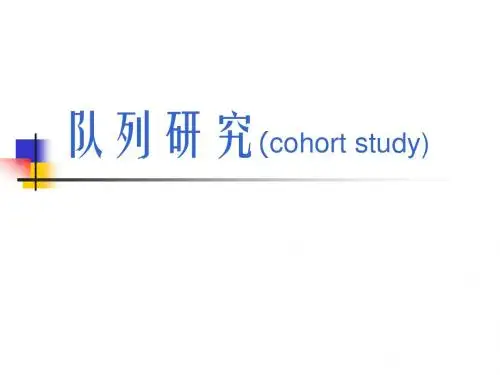队 列 研 究(Cohort Study)
- 格式:ppt
- 大小:2.58 MB
- 文档页数:90
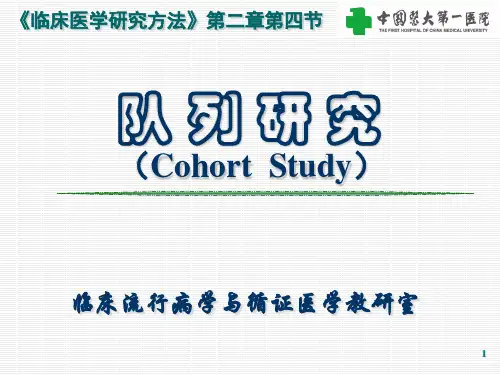
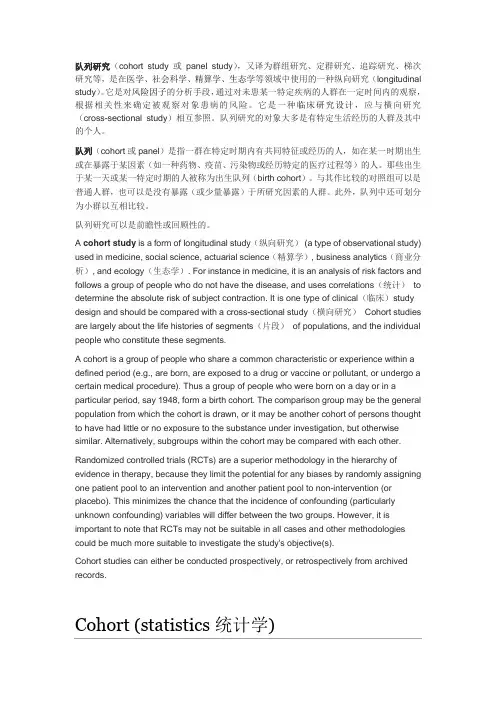
队列研究(cohort study 或panel study),又译为群组研究、定群研究、追踪研究、梯次研究等,是在医学、社会科学、精算学、生态学等领域中使用的一种纵向研究(longitudinal study)。
它是对风险因子的分析手段,通过对未患某一特定疾病的人群在一定时间内的观察,根据相关性来确定被观察对象患病的风险。
它是一种临床研究设计,应与横向研究(cross-sectional study)相互参照。
队列研究的对象大多是有特定生活经历的人群及其中的个人。
队列(cohort或panel)是指一群在特定时期内有共同特征或经历的人,如在某一时期出生或在暴露于某因素(如一种药物、疫苗、污染物或经历特定的医疗过程等)的人。
那些出生于某一天或某一特定时期的人被称为出生队列(birth cohort)。
与其作比较的对照组可以是普通人群,也可以是没有暴露(或少量暴露)于所研究因素的人群。
此外,队列中还可划分为小群以互相比较。
队列研究可以是前瞻性或回顾性的。
A cohort study is a form of longitudinal study(纵向研究) (a type of observational study) used in medicine, social science, actuarial science(精算学), business analytics(商业分析), and ecology(生态学). For instance in medicine, it is an analysis of risk factors and follows a group of people who do not have the disease, and uses correlations(统计)to determine the absolute risk of subject contraction. It is one type of clinical(临床)study design and should be compared with a cross-sectional study(横向研究)Cohort studies are largely about the life histories of segments(片段)of populations, and the individual people who constitute these segments.A cohort is a group of people who share a common characteristic or experience within a defined period (e.g., are born, are exposed to a drug or vaccine or pollutant, or undergo a certain medical procedure). Thus a group of people who were born on a day or in a particular period, say 1948, form a birth cohort. The comparison group may be the general population from which the cohort is drawn, or it may be another cohort of persons thought to have had little or no exposure to the substance under investigation, but otherwise similar. Alternatively, subgroups within the cohort may be compared with each other.Randomized controlled trials (RCTs) are a superior methodology in the hierarchy of evidence in therapy, because they limit the potential for any biases by randomly assigning one patient pool to an intervention and another patient pool to non-intervention (or placebo). This minimizes the chance that the incidence of confounding (particularly unknown confounding) variables will differ between the two groups. However, it is important to note that RCTs may not be suitable in all cases and other methodologies could be much more suitable to investigate the study's objective(s).Cohort studies can either be conducted prospectively, or retrospectively from archived records.Cohort (statistics统计学)In statistics and demography, a cohort is a group of subjects who have shared a particular event together during a particular time span(e.g., people born in Europe between 1918 and 1939; survivors of an aircrash; truck drivers who smoked between age 30 and 40). Cohorts may be tracked over extended periods in a cohort study. The cohort can be modified by censoring, i.e. excluding certain individuals from statistical calculations relating to time periods (e.g. after death) when their data would contaminate the conclusions.The term cohort can also be used where membership of a group is defined by some factor other than a time-based one: for example, where a study covers workers in many buildings, a cohort might consist of the people who work in a given building.Demography often contrasts cohort perspectives and period perspectives. For instance, the total cohort fertility rate is an index of the average completed family size for cohorts of women, but since it can only be known for women who have finished child-bearing, it cannot be measured for currently fertile women. It can be calculated as the sum of the cohort's age-specific fertility rates that obtain as it ages through time. In contrast, the total period fertility rate uses current age-specific fertility rates to calculate the completed family size for a notional woman were she to experience these fertility rates through her life.In medicine, a cohort study is often undertaken to obtain evidence to try to refute the existence of a suspected association between cause and effect; failure to refute a hypothesis often strengthens confidence in it. Crucially, the cohort is identified before the appearance of the disease under investigation. The study groups follow a group of people who do not have the disease for a period of time and see who develops the disease (new incidence). The cohort cannot therefore be defined as a group of people who already have the disease. Prospective (longitudinal) cohort studies between exposure and disease strongly aid in studying causal associations, though distinguishing true causality usually requires further corroboration from further experimental trials.The advantage of prospective cohort study data is that it can help determine risk factors for contracting a new disease because it is a longitudinal observation of the individual through time, and the collection of data at regular intervals, so recall error is reduced. However, cohort studies are expensive to conduct, are sensitive to attrition and take a long follow-up time to generate useful data. Nevertheless, the results that are obtained from long-term cohort studies are of substantially superior quality to those obtained from retrospective/cross-sectional studies. Prospective cohort studies are considered to yield the most reliable results in observational epidemiology. They enable a wide range of exposure-disease associations to be studied.Some cohort studies track groups of children from their birth, and record a wide range of information (exposures) about them. The value of a cohort study depends on the researchers' capacity to stay in touch with all members of the cohort. Some studies have continued for decades.In a cohort study, the population under investigation consists of individuals who are at risk of developing a specific disease or health outcome.[4]An example of an epidemiological(流行病学的)question that can be answered using a cohort study is: does exposure to X (say, smoking) associate with outcome Y (say, lung cancer)? Such a study would recruit a group of smokers and a group of non-smokers (the unexposed group) and follow them for a set period of time and note differences in the incidence of lung cancer between the groups at the end of this time. The groupsare matched in terms of many other variables such as economic status and other health status so that the variable being assessed, the independent variable (in this case, smoking) can be isolated as the cause of the dependent variable (in this case, lung cancer). In this example, a statistically significant increase in the incidence of lung cancer in the smoking group as compared to the non-smoking group is evidence in favor of the hypothesis. However, rare outcomes, such as lung cancer, are generally not studied with the use of a cohort study, but are rather studied with the use of a case-controlstudy.Shorter term studies are commonly used in medical research as a form of clinical trial, or means to test a particular hypothesis of clinical importance. Such studies typically follow two groups of patients for a period of time and compare an endpoint or outcome measure between the two groups.Randomized controlled trials, or RCTs are a superior methodology in the hierarchy of evidence, because they limit the potential for bias by randomly assigning one patient pool to an intervention and another patient pool to non-intervention (or placebo). This minimizes the chance that the incidence of confounding variables will differ between the two groups.Nevertheless, it is sometimes not practical or ethical to perform RCTs to answer a clinical question. To take our example, if we already had reasonable evidence that smoking causes lung cancer then persuading a pool of non-smokers to take up smoking in order to test this hypothesis would generally be considered quite unethical.Two examples of cohort studies that have been going on for more than 50 years arethe Framingham Heart Study and the National Child Development Study (NCDS), the most widely-researched of the British birth cohort studies. Key findings of NCDS and a detailed profile of the study appear in the International Journal of Epidemiology.The largest cohort study in women is the Nurses' Health Study. Started in 1976, it is tracking over 120,000 nurses and has been analyzed for many different conditions and outcomes.The largest cohort study in Africa is the Birth to Twenty Study, which began in 1990 and tracks a cohort of over 3,000 children born in the weeks following Nelson Mandela's release from prison.Other famous examples are the Grant Study tracking a number of Harvard graduates from ca. 1950.77, the Whitehall Study tracking 10,308 British civil servants, and theCaerphilly Heart Disease Study, which since 1979 has studied a representative sample of 2,512 men, drawn from the Welsh town of Caerphilly.。


队列研究(cohort study 或panel study),又译为群组研究、定群研究、追踪研究、梯次研究等,是在医学、社会科学、精算学、生态学等领域中使用的一种纵向研究(longitudinal study).它是对风险因子的分析手段,通过对未患某一特定疾病的人群在一定时间内的观察,根据相关性来确定被观察对象患病的风险。
它是一种临床研究设计,应与横向研究(cross-sectional study)相互参照。
队列研究的对象大多是有特定生活经历的人群及其中的个人.队列(cohort或panel)是指一群在特定时期内有共同特征或经历的人,如在某一时期出生或在暴露于某因素(如一种药物、疫苗、污染物或经历特定的医疗过程等)的人。
那些出生于某一天或某一特定时期的人被称为出生队列(birth cohort).与其作比较的对照组可以是普通人群,也可以是没有暴露(或少量暴露)于所研究因素的人群.此外,队列中还可划分为小群以互相比较。
队列研究可以是前瞻性或回顾性的。
A cohort study is a form of longitudinal study(纵向研究)(a type of observational study)used in medicine, social science, actuarial science(精算学),business analytics(商业分析), and ecology(生态学). For instance in medicine, it is an analysis of risk factors and follows a group of people who do not have the disease, and uses correlations(统计) to determine the absolute risk of subject contraction. It is one type of clinical(临床)study design and should be compared with a cross-sectional study(横向研究) Cohort studies are largely about the life histories of segments(片段) of populations, and the individual people who constitute these segments。
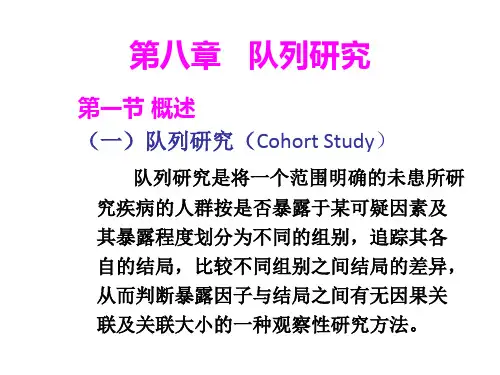
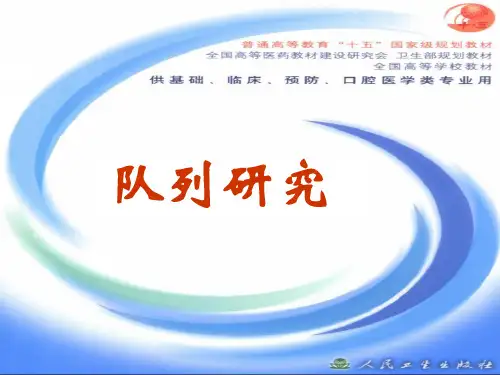
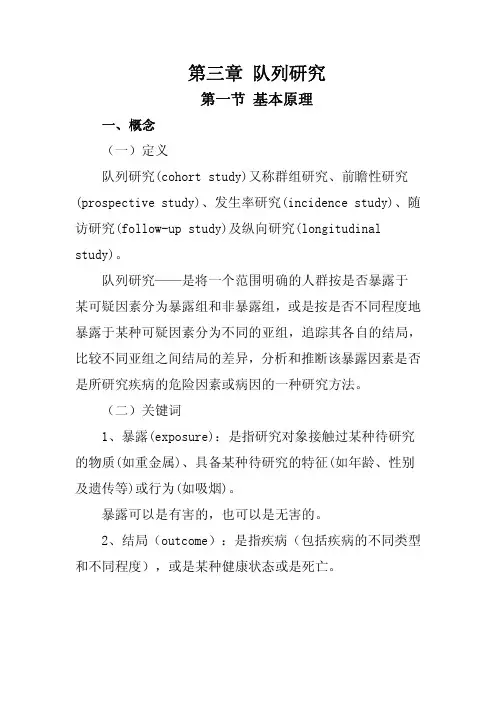
第三章 队列研究第一节 基本原理一、概念(一)定义队列研究(cohort study)又称群组研究、前瞻性研究(prospective study)、发生率研究(incidence study)、随访研究(follow-up study)及纵向研究(longitudinal study)。
队列研究——是将一个范围明确的人群按是否暴露于某可疑因素分为暴露组和非暴露组,或是按是否不同程度地暴露于某种可疑因素分为不同的亚组,追踪其各自的结局,比较不同亚组之间结局的差异,分析和推断该暴露因素是否是所研究疾病的危险因素或病因的一种研究方法。
(二)关键词1、暴露(exposure):是指研究对象接触过某种待研究的物质(如重金属)、具备某种待研究的特征(如年龄、性别及遗传等)或行为(如吸烟)。
暴露可以是有害的,也可以是无害的。
2、结局(outcome):是指疾病(包括疾病的不同类型和不同程度),或是某种健康状态或是死亡。
3、队列(cohort):是指一个特定的人群(群组)。
它是一组在特定时期出生的人群,或是一组有某种共同暴露或特征的人群。
固定队列(fixed cohort)——对象入队出队自始自终。
动态人群(dynamic population)——新对象随时加入,原成员不断退出。
4、危险因素(risk factor):又称为危险因子,泛指能引起某种疾病或不良健康状态发生或发生率增加的各种环境、行为、社会和遗传等因素。
二、基本原理:在一个特定人群中选择所需的研究对象,根据目前或过去某个时期是否暴露于某个待研究的危险因素,或其不同的暴露水平而将研究对象分成不同的组,如暴露组和非暴露组,高剂量暴露组和低剂量暴露组等,随访观察一段时间,检查并登记各组人群待研究的预期结局的发生情况(如疾病、死亡、或其他健康状况),比较各组结局的发生率,从而评价和检验危险因素与结局的关系。
判定:假使暴露组(或高剂量暴露组)预期结局的发生率显著高于非暴露组(或低剂量组)。
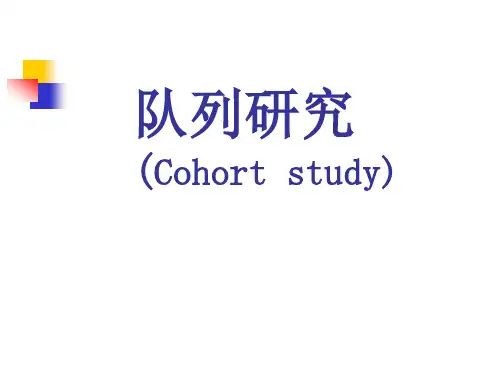
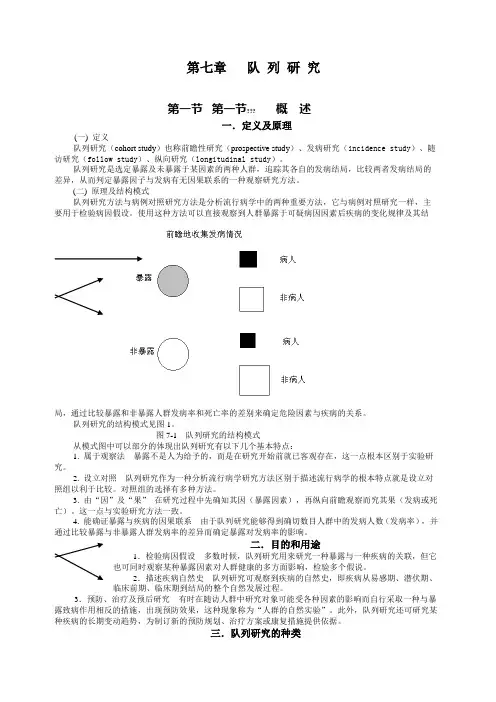
第七章队列研究第一节第一节??? 概述一.定义及原理(一) 定义队列研究(cohort study)也称前瞻性研究(prospective study)、发病研究(incidence study)、随访研究(follow study)、纵向研究(longitudinal study)。
队列研究是选定暴露及未暴露于某因素的两种人群,追踪其各自的发病结局,比较两者发病结局的差异,从而判定暴露因子与发病有无因果联系的一种观察研究方法。
(二) 原理及结构模式队列研究方法与病例对照研究方法是分析流行病学中的两种重要方法,它与病例对照研究一样,主要用于检验病因假设。
使用这种方法可以直接观察到人群暴露于可疑病因因素后疾病的变化规律及其结局,通过比较暴露和非暴露人群发病率和死亡率的差别来确定危险因素与疾病的关系。
队列研究的结构模式见图1。
图7-1 队列研究的结构模式从模式图中可以部分的体现出队列研究有以下几个基本特点:1. 属于观察法暴露不是人为给予的,而是在研究开始前就已客观存在,这一点根本区别于实验研究。
2. 设立对照队列研究作为一种分析流行病学研究方法区别于描述流行病学的根本特点就是设立对照组以利于比较。
对照组的选择有多种方法。
3. 由“因”及“果”在研究过程中先确知其因(暴露因素),再纵向前瞻观察而究其果(发病或死亡)。
这一点与实验研究方法一致。
4. 能确证暴露与疾病的因果联系由于队列研究能够得到确切数目人群中的发病人数(发病率),并通过比较暴露与非暴露人群发病率的差异而确定暴露对发病率的影响。
二.目的和用途1.检验病因假设多数时候,队列研究用来研究一种暴露与一种疾病的关联,但它也可同时观察某种暴露因素对人群健康的多方面影响,检验多个假说。
2.描述疾病自然史队列研究可观察到疾病的自然史,即疾病从易感期、潜伏期、临床前期、临床期到结局的整个自然发展过程。
3.预防、治疗及预后研究有时在随访人群中研究对象可能受各种因素的影响而自行采取一种与暴露致病作用相反的措施,出现预防效果,这种现象称为“人群的自然实验”。
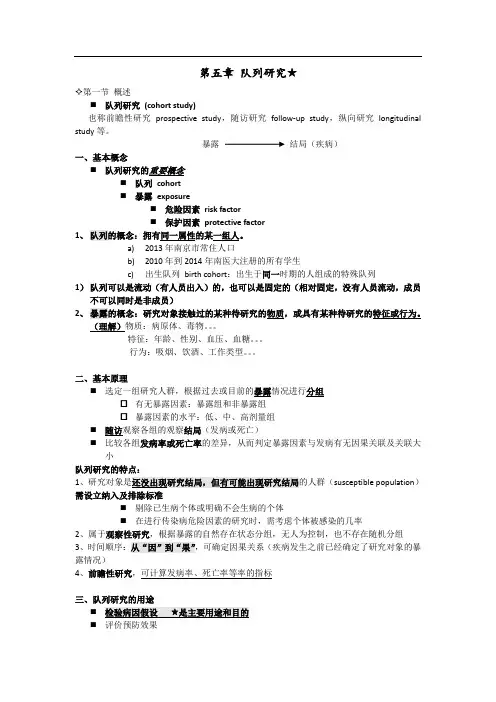
第五章队列研究★✧第一节概述⏹队列研究(cohort study)也称前瞻性研究prospective study,随访研究follow-up study,纵向研究longitudinal study等。
暴露结局(疾病)一、基本概念⏹队列研究的重要概念⏹队列cohort⏹暴露exposure⏹危险因素risk factor⏹保护因素protective factor1、队列的概念:拥有同一属性的某一组人。
a)2013年南京市常住人口b)2010年到2014年南医大注册的所有学生c)出生队列birth cohort:出生于同一时期的人组成的特殊队列1)队列可以是流动(有人员出入)的,也可以是固定的(相对固定,没有人员流动,成员不可以同时是非成员)2、暴露的概念:研究对象接触过的某种待研究的物质,或具有某种待研究的特征或行为。
(理解)物质:病原体、毒物。
特征:年龄、性别、血压、血糖。
行为:吸烟、饮酒、工作类型。
二、基本原理⏹选定一组研究人群,根据过去或目前的暴露情况进行分组☐有无暴露因素:暴露组和非暴露组☐暴露因素的水平:低、中、高剂量组⏹随访观察各组的观察结局(发病或死亡)⏹比较各组发病率或死亡率的差异,从而判定暴露因素与发病有无因果关联及关联大小队列研究的特点:1susceptible population)需设立纳入及排除标准⏹剔除已生病个体或明确不会生病的个体⏹在进行传染病危险因素的研究时,需考虑个体被感染的几率2、属于观察性研究,根据暴露的自然存在状态分组,无人为控制,也不存在随机分组3、时间顺序:从“因”到“果”,可确定因果关系(疾病发生之前已经确定了研究对象的暴露情况)4、前瞻性研究,可计算发病率、死亡率等率的指标三、队列研究的用途⏹⏹评价预防效果⏹研究疾病的自然史⏹新药的上市后监测四、队列研究的类型1、前瞻性队列prospective cohort也称即时性或同步性(concurrent) 队列开始研究时确定对象、分组,经随访得到结局优点:资料准确缺点:样本大,花费大,时间长建立队列时要特别考虑能否负担得起,能否获得想要的结果!2、回顾性队列retrospective cohort也称历史性(historical) 或非即时性(non-concurrent) 队列研究开始时疾病结局已发生,研究对象是过去进入队列的,分组依据的是过去的暴露资料 优点:省人、物、时缺点:依赖历史资料的完整与可靠,常缺乏混杂因素的资料3、双向性队列ambispective cohort历史队列后继续进行前瞻性队列最适合于对人体健康同时具有短期和远期效应的暴露因素研究✧第二节研究设计与实施一、确定研究因素队列研究最主要的目的:进一步验证现况调查或病例对照研究中已发现的有特异影响、且在统计学上有联系的危险(或保护)因素。
